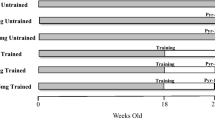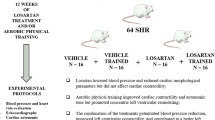Summary
Alterations of myocardial mechanical catecholamine responsiveness by swimming training (2×90 min/day, 4 weeks) were examined in 13-week-old spontaneously hypertensive male rats (SHR). The relationships between myocardial mechanical catecholamine responsiveness and ventricular β-adrenoceptors as well as myosin isoenzyme pattern were also examined. Compared with sedentary controls, trained rats showed a greater responsiveness to isoproterenol (10−6 mol/l) on isometric tension (T) and its first derivative (dT/dt) (ΔT:0.45±0.55 vs. −0.15±0.11 10−2 N/mm2, p<0.01, ΔdT/dt: 17.1±10.1 vs. 8.3±3.6 10−2 N/mm2·s, p<0.05). In sedentary SHR, dT/dtmax increased significantly, whereas developed tension decreased slightly, coupled with a decrease of time to peak tension by high dose (10−6 mol/l) isoproterenol. Therefore, it can be stated that dT/dt is a better indicator for catecholamine sensitivity than isometric tension. β-adrenoceptor density ([3H]-dihydroalprenolol binding) decreased significantly in trained rats (68.7±7.62 vs. 102.4±4.37 fmol/mg protein, p<0.01) with no significant difference in KD values (4.61±2.26 vs. 6.11±1.94 nM, ns). In addition, myosin isoenzyme pattern revealed by pyrophosphate gel electrophoresis shifted towards VM-1 after swimming training. The increased catecholamine sensitivity of fast contracting myocardium is, in principle, compatible with the assumption of cAMP-dependent regulation of myofibrillar ATPase activity (21) or cross bridge kinetics (9), although other postreceptor processes should also be taken into consideration for the increased catecholamine sensitivity.
Similar content being viewed by others
References
Alexander RW, Galper JB, Neer EJ, Smith TW (1982) Noncoordinate development of β-adrenergic receptors and adenylate cyclase in chick heart. Biochem J 204:825–830
Ayobe MH, Tarazi RC (1983) Beta-receptors and contractile reserve in left ventricular hypertrophy. Hypertension 5 (suppl I):192–197
Bradford MM (1976) A rapid and sensitive method of the quantitation of microgram quantities of protein utilizing in the principle of protein-dye binding. Anal Biochem 72:248–254
Cervoni P, Herzlinger H, Lai FM, Tanikella T (1981) A comparison of cardiac reactivity and β-adrenoceptor number and affinity between aorta-coarcted hypertensive and normotensive rats. Br J Pharmac 74:517–523
d'Albis A, Pantaloni C, Becher J-J (1979) An electrophoretic study of native myosin isoenzymes and of their subunits content. Eur J Biochem 99:261–272
Glitzsche O (1983) The adrenergic beta-receptor adenylate cyclase system in heart and lymphocytes from streptozotocin-diabetic rats. In vivo and in vitro evidence for a desensitized myocardial betareceptor. Diabetes 32, 1110–1116
Heyliger CE, Price GN, Signal PK, Beamish RE, Dhalla NS (1982) Cardiac alpha- and betaadrenergic receptor alterations in diabetic cardiomyopathy. Basic Res Cardiol 77:610–618
Hoh HFY, McGrath PA, Hale PT (1978) Electrophoretic analysis of multiple forms of rat cardiac myosin: effects of hypophysectomy and thyroxine replacement. J Mol Cell Cardiol 10:1053–1076
Hoh JFY, Rossmanith GH (1983) Crossbridge dynamics in rat papillary muscles containing V1 and V2 isomyosins: effect of adrenaline. J Mol Cell Cardiol 15:(suppl 2) 65 (abst)
Jacob R, Kissling G, Ebrecht G, Holubarsch C, Medugorac I, Rupp H (1983) Adaptive and pathological alterations in experimental cardiac hypertrophy. In: Chazov E, Saks V, Rona G (eds) Advances in Myocardiology, Vol 4, pp 55–77. Plenum Publishing Corporation, New York
Judy WV, Watanabe AM, Henry DP, Besch HR Jr, Murphy WR, Hockel GM (1976) Sympathetic nerve activity. Role in regulation of blood pressure in the spontaneously hypertensive rat. Circ Res 38 (suppl II):21–29
Malhotra A, Penpargkul S, Schible T, Scheuer J (1981) Contractile proteins and sarcoplasmic reticulum in physiologic cardiac hypertrophy. Am J Physiol 241:H263-H267
Östman-Smith I (1979) Adaptive changes in the sympathetic nervous system and some effector organs of the rat following long term exercise or cold acclimation and the role of cardiac sympathetic nerves in the genesis of compensatory cardiac hypertrophy. Acta Physiol Scand Suppl 477:1–118
Penpargkul S, Repke DI, Katz AM, Scheuer J (1977) Effect of physical training on calcium transport by rat cardiac sarcoplasmic reticulum. Circ Res 40:134–138
Rupp H, Jacob R (1982) Response of blood pressure and cardiac myosin plymorphism to swimming training in the spontaneously hypertensive rat. Can J Physiol Pharmacol 60:1098–1103
Rupp H, Bukhari AR, Jacob R (1983) Modulation of catecholamine synthesizing and degrading enzymes by swimming and emotional excitation in the rat. In: Jacob R, Gülch RW, Kissling G (eds) Cardiac adaptation to hemodynamic overload, training and stress, pp 267–273. Dr D Steinkopff Verlag. Darmstadt
Scatchard G (1949) The attractions of proteins for small molecules and ions. Ann NY Acad Sci 51:660–672
Takeda N, Dominiak P, Türck D, Rupp H, Jacob R (1985) The influence of endurance-training on mechanical catecholamine responsiveness, β-adrenoceptor density and myosin isoenzyme pattern of rat ventricular myocardium. Basic Res Cardiol 80:88–99
Tibbits GF, Barnard RJ, Baldwin KM, Cugalj J, Roberts NK (1981) Influence of exercise on excitation-contraction coupling in rat myocardium. Am J Physiol 240:H472-H480
Williams RS, Lefkowitz RJ (1978) Alpha-adrenergic receptors in rat myocardium. Identification by binding of [3H]dihydroergocryptine. Circ Res 43:721–727
Winegrad S, McClellan G, Tucker M, Lin L-E (1983) Cyclic AMP regulation of myosin isoenzymes in mammalian cardiac muscle. J Gen Physiol 81:749–765
Wyatt HL, Chuck L, Rabinowitz B, Tyberg JV, Parmley WW (1978) Enhanced cardiac response to catecholamines in physically trained cats. Am J Physiol 234:H608-H613
Author information
Authors and Affiliations
Additional information
Supported by the Deutsche Forschungsgemeinschaft
Rights and permissions
About this article
Cite this article
Takeda, N., Dominiak, P., Türck, D. et al. Myocardial catecholamine responsiveness of spontaneously hypertensive rats as influenced by swimming training. Basic Res Cardiol 80, 384–391 (1985). https://doi.org/10.1007/BF01908182
Received:
Issue Date:
DOI: https://doi.org/10.1007/BF01908182




